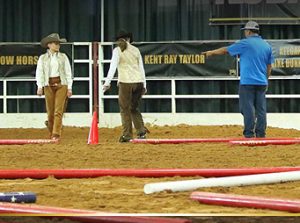Perfecting Pole Work for the Young or Green Horse
Click here to read the complete article194 – March/April 2019
By Kristen Spinning
 These days, a Trail course can seem like an endless sea of poles: pinwheels, serpentines, and chutes. No matter the graphic complexity of all those lines, at any point in the pattern, you’re only dealing with one pole. Breaking a pattern down to that basic element not only helps eliminate the overwhelming aspects of the course, it’s the starting point of training a young or green horse the fundamentals of Trail work. Three Trail experts share their reasoning for perfecting pole work, starting with a single log.
These days, a Trail course can seem like an endless sea of poles: pinwheels, serpentines, and chutes. No matter the graphic complexity of all those lines, at any point in the pattern, you’re only dealing with one pole. Breaking a pattern down to that basic element not only helps eliminate the overwhelming aspects of the course, it’s the starting point of training a young or green horse the fundamentals of Trail work. Three Trail experts share their reasoning for perfecting pole work, starting with a single log.
RYAN COTTINGIM
Ryan Cottingim trains a diverse group of open horses and Non Pro riders at every level. He describes his program as being fundamentally and mechanically based. Repetition and routine are his keys to starting young horses on poles, and that foundation is something he can always return to at any point. He has no problem taking a horse right back to step one – the single pole – whenever an issue might pop up.
Ryan assesses each young Trail horse individually to determine when they’re ready, saying, “I will start them over poles when I have some body control, some foot control, and some shape or collection. I’ve started some young two-year olds that weren’t necessarily at show speed yet. They weren’t going slow with their heads down, but they were strong enough mechanically to start teaching them the fundamentals of going over the poles.” On the other side, he’s introduced poles to horses that have already had a successful Western Pleasure career. In those cases, “they may have their show speed and their head low, but we still need to teach them a different type of body control before we can go over poles.” At either end of the spectrum, his ideal is to start with a very fundamentally grounded horse, in terms of body control and foot placement, before introducing a new set of cues and a change in stride. He reasons, “A two- or three-year-old has been taught to be comfortable at a certain stride for Western Pleasure, Horsemanship, or even Hunter Under Saddle. He’s been conditioned to do another event. His education tells him that he’s not supposed to take a six-foot stride at the lope or have a three-foot trot. Maybe he’s Hunter-bred and his stride is a little too open.” Ryan employs patience and understanding to move the horse into a zone where he’s comfortable with the stride collection and extension that’s needed for Trail. He also makes it clear to the horse that it’s still okay to have that shorter stride for other events and to be comfortable with a longer, more open stride as well.
Once proper stride length is established, Ryan moves into refining foot placement ahead of the pole. Again, repetition is key to giving a horse the proper step to get to the pole with the desired cadence, rhythm, and a good collected step every stride. He continues with single pole exercises to develop that consistency. He wants to place their feet at a point about eight inches in front of the pole. He says, “I’m going to circle it, walk, trot, and lope both ways until it’s almost automatic that the horse is going to leave from that same spot to go over the pole. It’s my job to help place him there and develop the confidence that if that’s where he leaves from, he’s in a great spot. He doesn’t hit, and he doesn’t break gait.”
Click the link below to read more from Ryan Cottingim, Tim Kimura, and Jason Gilliam.
Click here to read the complete article194 – March/April 2019










